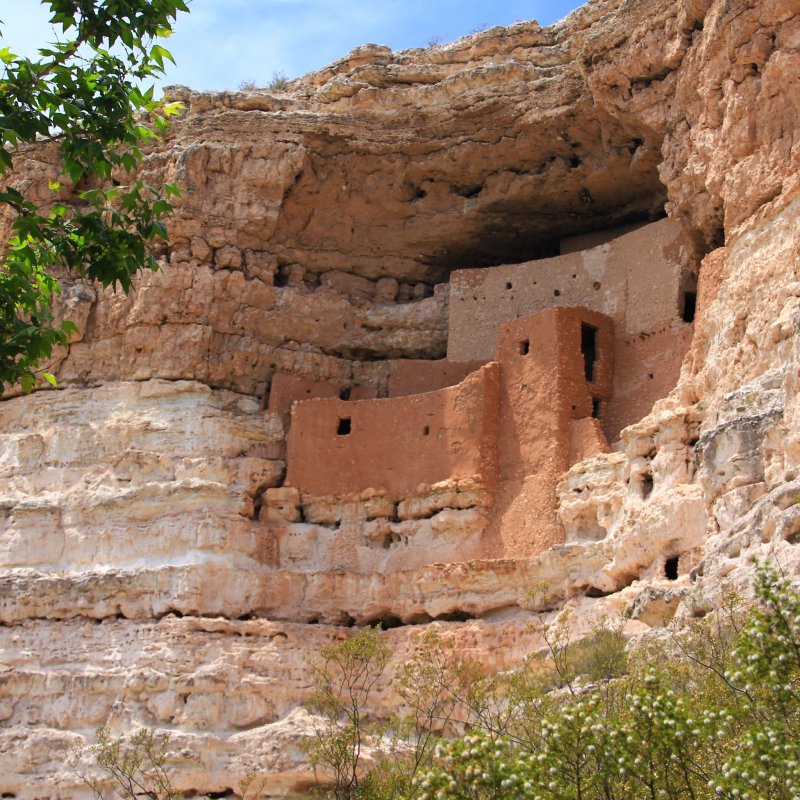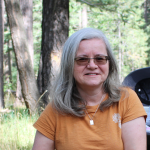
One of the best-preserved cliff dwellings in the U.S. Southwest, Montezuma Castle preserves the legacy of the ancient people living in the high deserts of Arizona. Built into a limestone cliff, the five-story-tall, 20-room structure is one of the greatest examples of the ingenuity of its builders — people who not only survived but who thrived in an inhospitable environment.
Videos by TravelAwaits
Easy to access from Highway I-17 between Phoenix and Flagstaff, Montezuma Castle National Monument makes a great day trip from either place. Here are a few facts about the “castle” and its environment to help you get the most out of your visit.
1. Montezuma Castle Is A Misnomer
When hearing the name Montezuma, most people think of the legendary Aztec ruler who reigned in the land that is today Mexico. However, he had nothing to do with this Montezuma Castle in Arizona, thousands of miles from his homeland, inhabited at least a century before he was born.
Nor is the structure built into a limestone cliff a “castle” in the traditional sense. It was, in fact, home to an entire village.
However, when you see the spectacular, five-story building carved right into the rocks, you might understand why its first visitors in the 1860s mistook the structure for a castle. They were miners and soldiers, who heard of King Montezuma and could only imagine a king’s castle being as elaborate as this structure was. So, they named the ruins they came upon Montezuma Castle.

2. The Site Is A Cliff Dwelling
The structure mistaken for a castle by its first visitors is a cliff dwelling, common in the U.S. Southwest, though this is one of the best-preserved known so far. Cliff dwellings are structures, homes of individual families, or entire villages built in the crevices, niches, or caves of high cliffs.
The rooms of the Montezuma Castle cliff dwelling sit on ledges of natural caves on a 150-foot-high limestone cliff. The site housed an entire village of ancient indigenous people in Arizona.
3. Indigenous People We Call The Sinagua Built Montezuma Castle
Since we don’t know the name they called themselves, we call the people who built Montezuma Castle and many of the surrounding ancient structures the Sinagua. The term originates in Spanish and means “without water,” referring to the landscape they made their home in, an area without, or with very little, water.
Dr. Harold Colton, the founder of the Museum of Northern Arizona, was the first one to call the ancient people of Verde Valley and the vicinity of Flagstaff the Sinagua. He borrowed the term from the Spanish, who called the San Francisco Peaks la sierra sin agua, which translates to “the mountain without water.”
The name fits for people who could survive and build a civilization in an area with very little water. The Sinagua built the cliff dwelling known as Montezuma Castle between 1100 and 1350 and abandoned it by 1425.
Though we don’t know what the ancient Sinagua called themselves, we now know who they were: The ancestors of the present-day Pueblo tribes of Arizona. They were hunter-gatherers and farmers, growing mainly corn, beans, and squash. The artifacts at Montezuma Castle prove they were also great craftsmen, weavers, and tradesmen.
Archaeologists couldn’t come up with an explanation for why they abandoned the area after a short time, but they guessed drought or depletion of their environment. While all this must have played a role, according to their descendants, the site was a stop on a larger migration journey and was never meant to be lived in longer.

4. Montezuma Castle Lies In Verde Valley
The village we know as Montezuma Castle was not an isolated structure where people lived for generations without contact with their neighbors. The “castle” was part of a large community living in Verde Valley in Central Arizona.
Archaeologists estimate that about 6,000 to 8,000 people lived in the area, in small villages, about two miles apart. At the edge of the pine-forested Mogollon Rim, Verde Valley was a great place for these villages in a land of little water.
Forming a transition area between desert, grasslands, and forest vegetation zones, it is an area fit for growing a few crops while offering areas of shade from the intense sun, and water, even if seasonal in most parts.
5. Verde Valley Is Home To A Variety Of Plant And Animal Life
Verde Valley and the area in and around Montezuma Castle National Monument support a wide variety of flora and fauna, more than you would expect from a semi-arid upland area with barely any rainfall.
From riverside areas to high desert plateaus, the vegetation evolved to handle the stress of desert life. You’ll find prickly pear and yucca varieties, creosote, mesquite, and desert willow here, among other species, but the most stunning tree here is the Arizona sycamore. This large deciduous tree with smooth, white bark grows up to 80 feet in height and offers shade in the arid environment while preventing erosion and providing homes for birds of Arizona.
Over 200 species of birds live in the area, including Gambel’s quails, doves, roadrunners, raptors, woodpeckers, flycatchers, sparrows, and owls, among many others. Lizards are common here. You’ll see them along the trail sunbathing or chasing insects, no matter when you visit.
A wide variety of mammals live in the area, and you might see some, like mule deer, desert cottontails, ground squirrels, and even elk.

6. The Spectacular Cliff Dwelling Became A National Monument In 1906
Montezuma Castle and the surrounding area became a National Monument as part of the American Antiquities Act in 1906. It is one of the four original sites of historic and cultural significance designated by President Roosevelt as National Monuments.
Included in the Montezuma Castle National Monument is Montezuma Well, a natural sinkhole just 11 miles from the “castle.” The well was also home to another Sinagua village; you can see a few of their cliff dwellings on its steep walls beside a few other structures.
7. It Is Easy To Visit Montezuma Castle National Monument
Montezuma Castle and Well are both easily accessible from Highway I-17, 95 miles north of Phoenix and 55 miles south of Flagstaff. Stop at Montezuma Castle first, since you’ll find the visitor center here, offering information on both sites.
The paved, .33-mile loop trail takes you to the castle and past it, in the shadow of large Arizona sycamore trees, and offers gorgeous, unobstructed views of the cliff dwelling. You can’t enter the cliff dwelling, but enjoy it from the viewpoints. The trail is fully accessible.
Montezuma Well features a half-mile-long paved trail, where you can encounter geology, plant, and animal life found nowhere else on the planet. Though the trail around the well is paved, it’s steep, and stairs and rocks prevent it from being fully accessible. However, it is a great place to see wildlife along the top of the well. Rangers or volunteers might be available at the Viewing Stations to point out wildlife in and around the water.
The Montezuma Well area features a picnic area where you can stop for lunch in the shade of tall sycamore and cottonwood trees.
8. You Can Take A Virtual Tour Of Montezuma Castle
If you want to see Montezuma Castle, but can’t make it to Arizona, you can take a virtual tour. Montezuma Castle artist-in-residence Darius Nabors created a virtual tour of the trail in 2019. You can walk the trail and enjoy views of the castle and its surroundings without leaving your home through this interactive tour.

9. The Sinagua Built Other Villages, And You Can Visit Their Ruins, Too
Tuzigoot, Walnut Canyon, and the villages at Wupatki National Monument are only a few of the other ruins in Central and Northern Arizona left behind by the Sinagua. You can visit all of them during a trip through Arizona and as day trips from either Flagstaff or Phoenix.
Pro Tips
When visiting Montezuma Castle National Monument, remember that you are in a desert environment. The humidity in the air is low, so you can get dehydrated even when it’s not too hot and not even realize it. Make sure you carry water and drink often. Even though the trails are short, you can get sunburned during the summer or on sunny days, so wear a hat and sunscreen.
Be aware of the cacti around you while hiking. Some species, like the cholla varieties, have barbed spines that detach at the lightest touch and embed in your skin, making them painful to get out. Others have spines so tiny you won’t even see them but can end up with your skin filled with them. Do not touch them, no matter how tempting it may be.
Rattlesnakes are common in and around Montezuma Castle, though you are not likely to see them. They are beneficial because they keep the rodent population in check, but they hide from us. If you see one, don’t panic, but don’t stop to take photos either. Walk slowly and quietly behind it, as far from it as possible. To avoid an unwelcome encounter, stay on the trails.
